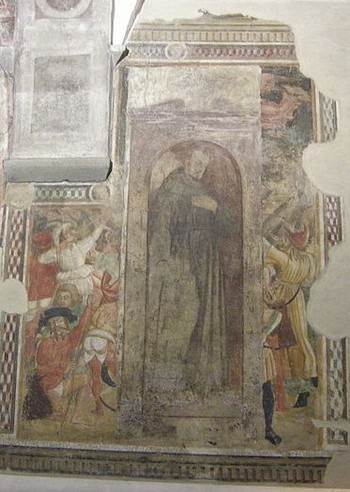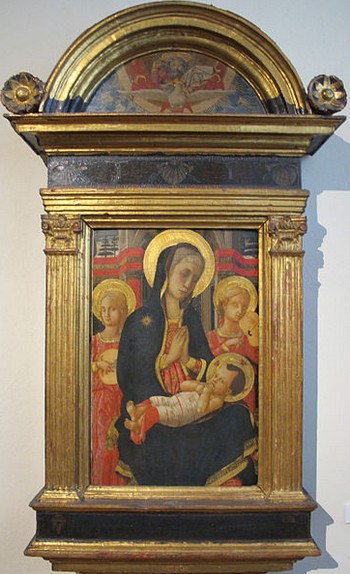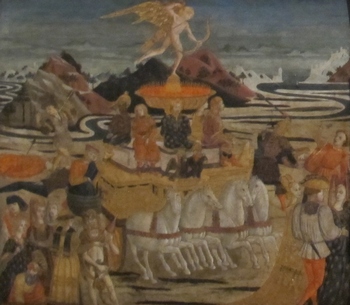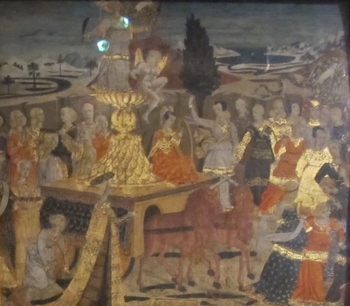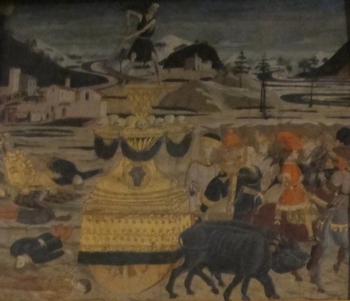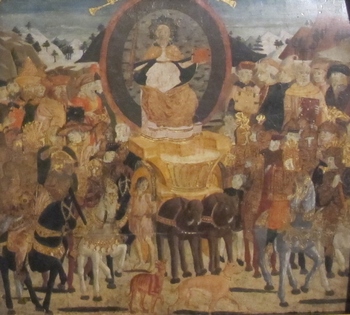Introduction
This note had originally been motivated by two different reasons. The first was that I had continued to reflect on the production of Giovanni di Ser Giovanni, and wished to further comment on his packs of Naibi traded in Puri’s shop.(1)
The second reason was that I wished to report another original finding of mine: an ordinary activity of Giovanni, documented in a book of Ricordanze.(2) The latter reason has lost its value in the meantime, because I have seen this document already published in a book dealing with our artist.(3)
In conclusion, this note will not contain any really new information, but only a few comments on already known matters, discussing some interesting features in a seemingly scattered production.
1. Giovanni di Ser Giovanni Guidi detto Lo Scheggia
Giovanni was born in San Giovanni Valdarno in 1406, soon after the death of his father, the notary Ser Giovanni; this circumstance allowed him to receive the same name of his father. The Guidi surname is not at all a proof that they belonged to that ancient Tuscan family. Our artist was the younger brother of Masaccio; probably this fact has made it easier for art historians to study his life in a deeper way, in comparison with artists of the same level.(4)
A milestone in these studies has been a long article, compiled with much documentary information from various Catasto books, and similar archival sources.(5) The essential parts of this information, and some further data, can be found in recent books dealing with the Florentine painters of the time, such as that by Jacobsen,(6) or directly with Giovanni himself.(3)
We can state that in the early 1450s, of main interest here, Giovanni was less modern and less typically belonging to the new Florentine artistic movement than had been his brother Masaccio thirty years earlier on. However, his works show some influence from the innovative production of his brother – how much still is a debated question among art historians.
Masaccio died young in 1428, but Giovanni had a long and active life. He obtained a remarkable success and richness among Florentine painters and at his death in 1486 he was buried in the celebrated Santa Croce church.
2. Art works produced by Giovanni
Our artist was involved in several kinds of artistic production. Let us examine the main aspects of his activity and provide some illustrative examples for the various sectors.
2.1 Frescoes and major panel paintings
The two techniques of the subtitle were the most appreciated at the time and thus continue to be in the analyses of the art experts of nowadays. Was Giovanni an acknowledged author in this valuable domain? Yes and no; it depends especially on the location.
If we limit our horizon to Florence, we find there several great artists active, who produced in early 15th century pioneering masterpieces, works that gave birth to the new Renaissance style, which slowly spread in other parts of Italy, and then of Europe too.
These Florentine masterpieces were copied and imitated for centuries and these painters obtained a perennial fame. Among them, we find Masaccio as one of the earliest and greatest. His brother Giovanni is instead only familiar to a small group of art historians. We never meet Giovanni in great works commissioned within the main Florentine churches, or by the richest Florentine merchants of the time.
Nevertheless, we know that he was capable of producing beautiful paintings and frescoes and that he was also produced religious images, typical of the time. Fact is that he only got his commissions from his home town, Castel San Giovanni (now San Giovanni Valdarno), or nearby places. Apparently, his fame as a great painter was recognised well enough in the countryside, where he was known as a Florentine painter coming precisely from those places.
How he was considered by the population in the town and in the surrounding territory is thus relatively clear: too minor a painter to work at top level in the town, too famous one not to obtain commissions in the country side.
Something ambiguous seems to occur with art critics too. The problem here is that his production has only recently been attributed to him: until recently, he was considered as the unknown Maestro di Fucecchio, or Maestro del cassone Adimari, from a few of his works that had called the attention of art historians.(7)
Nowadays, his name is better known and several dozen works are attributed to him, with more or less confidence.(8) The judgement on his production remains however somewhat intermediate, a good painter, not an extraordinary artist.
As for the contents of this production, it is obvious that the religious subjects had the greatest involvement, especially among frescos,(9) but also in the section of major panel paintings.(10)
They may contain some useful detail for us too: a little interesting Madonna may have in her image some features, which one can find duplicated in a most interesting ancient playing card. Now, even if I am prepared to accept this unconventional hierarchy for art works, my old studies and some familiarity with the Florentine milieu are not enough to let me propose such comparisons myself.
The only point that I have examined is whether Giovanni could introduce in this kind of production some triumphal patterns. This survey has not proceeded deep enough, but I found no encouraging result up to now. On the other hand, in a religious image painted for a church there is no apparent justification for triumphal subjects, extraneous to the catholic tradition.
We can thus better search in the remaining parts of his complex production. What remains to examine is something different: instead of a minor painter involved in art works at top level, we will find a top-level maker of minor art products.
2.2 Activity as a Forzerinaio
Giovanni probably was mainly a Forzerinaio. Carpenters’ workshops were common in San Giovanni and Giovanni’s grandfather was involved in that activity. When in Florence, Giovanni added to this expertise that of painting, but never forgot his previous knowledge.
We can find a clear prove of this situation in the subsequent matriculations of Giovanni, first in Arte dei Legnaiuoli, then in 1433 in Arte dei Medici e Speziali, which accepted painters. For painters, the matriculation in the latter Arte was usually only the final stage of their career, and in many cases they even did not apply at all, because of the higher inscription fees.
Which was the activity of a Forzerinaio? The name derives from Forziere, a chest for keeping money in a safe way, with a hard-to-force lock and often the wood parts reinforced with iron pins. These objects could be of various dimension and quality, decoration included.
There were in addition many kinds of chests for different uses. Probably the more current name for an object of this kind was Cofano, but several names were in common use, also because there were several kinds and dimensions for these items.
As occurred for many products, the final object could be either the result of the activity of several specialists or of an individual manufacturer, who was competent enough in all the different aspects of the job. Of course, in the case of Giovanni, he certainly did not need to forward his wooden product to a painter, in order to have it suitably decorated.
2.2.1 Tarsie
A special kind of decoration that first obtained a significant spread in those years was the Tarsia or inlay-work; here too, inlayer specialists became active. I am not willing to repeat here what one can easily find in the web pages, to begin with those of en.wikipedia.org/wiki. If anybody is not fully conversant with such terms as Intarsia, Desco da parto, Cassone, Miniature, and similar objects, it is now easy to find a suitable general information about them just using the mentioned link.
One of the most prestigious jobs documented for Giovanni was his participation in the inlay-works of Santa Maria del Fiore, the Florentine Cathedral, indicated by the example shown in the figure.(11) It seems that a remarkable part of the Tarsie in the sacristy had been created by Giovanni himself, even if the manual work was then done by specialists in inlay works.
To have obtained a similar contract was of course a clear sign of fame: a little known artist could hardly work in Santa Maria del Fiore, at least at the time.
2.2.2 Cassoni
Under the name of Cassoni we know a particular kind of chests that were produced at the time. They were typically connected with the wedding ceremonies: the bride let her Cassone be brought into the new house with her trousseau inside. Thus, it was first of all a container: years could be needed in order to gradually fill it up with personal clothes, linens, and the several objects that traditionally any woman brought with her when married. Among these objects, one could find a mirror, some combs, a pair of scissors, a silver thimble, a decorated penknife, and so on.
The Cassone was however not only a container for the transport of these objects: it was intended to remain as a piece of furniture in the new house, often at the foot of the double bed. It had thus to be essentially considered as a decorated piece of furniture.
Cassoni, as well as decorated Cofani more generally, were traditional products of the Florentine craftsmen already for a long time. For instance, many Cofani made in Florence were imported into Avignon in the end of the 14th century to be sold in the store of Francesco di Marco Datini.(12)
A common operation in producing Cassoni was that a Forzerinaio made the carpenter’s job leaving some free space for inserting the wooden tables separately decorated by a painter. (Of course an artist with Giovanni’s experience could perform both tasks by himself.)
The painting technique for these works, and for some of those commented later on, was the same tempera painting used for the major panel products with religious subjects. These were however considered as minor art works, owing to their profane subjects and smaller dimensions. Everybody with some money available could acquire such minor paintings.
What is of particular interest here is that at a given time triumphal motives appeared in the Cassoni decorations, and Giovanni himself made some of these “new” objects, as can be seen in the specimen reproduced here.(13)
An interesting variation of Cassone was Cassapanca, a chest-bench, provided with a back that could be decorated in its turn. Probably panels for such a back are the four triumphs attributed to Giovanni and kept in Pinacoteca Nazionale of Siena.(14)
2.2.3 Deschi
We read that the production of Deschi da parto had a significant spread soon after the Black Death, in the middle of the 14th century, when the population of Florence had ruinously reduced to less than a half. More than ever before, the birth of a new child became a welcome event and more care was provided to both mother and baby, in order to save their lives.
These objects had either a polygonal or a circular shape and were first used by women in childbirth in order to have their meals while lying in bed. After this specific utilisation, the same objects could be used as simple trays, or as art works that could be hung as decorations on the walls.
Experts still debate whether such objects were also included among wedding presents, as wishing an imminent pregnancy. I personally did never find them in the many lists of trousseaus that I have examined here and there.
Usually, the producers of these objects had several specimens almost ready for sale and whenever one of them was ordered, they just finished it adding some specific feature of the family, typically the family coat of arms painted on the back of the Desco.
A different question, which may however be relevant for our field of the history of playing cards, is when triumphal images began to be used for decorating these objects.
In the case under examination, the production by Lo Scheggia, we find excellent examples of precisely these objects, decorated with triumphal motives. It suffices to call the attention on the Desco used for the birth of nobody less than Lorenzo il Magnifico.(15) It shows a beautiful image of the triumph of Fame, whereas other similar Deschi by Giovanni are known with the triumph of Love, and so on.
The fact that Giovanni obtained commissions from the Medici family, and other ones at the highest social level, is a clear proof that his fame was deeply rooted in the Florentine environment.
2.3. Other paintings
We have already found a variety of art objects in Giovanni’s production, but we can extend further the field of our analysis. Now, instead of wood, we find parchment or paper as a painting substrate.
2.3.1 Miniature
I could find no miniature attributed to Giovanni. This is not surprising, if one considers that several painters existed, who were specialised in this sector of painting products. Giovanni was so deeply involved in working with and on wooden materials, that he could hardly be fully conversant with the minute drawings in those small parts of book pages.
We can neglect the whole topic of Miniature for our artist. However, several of his colleagues could be involved in the production of Miniature together with other painting kinds. It will be hard to find a painter, who could excel in every art production that flourished at the time. It is however true that most painters followed various kind of works at the same time.
Now, Italian Miniature obtained in the 15th century their most renowned masterpieces. Earlier on, they had an inferior quality in comparison with the production of the Flanders, or France; later on, with the spread of printed books, their importance practically vanished.
In the field of Miniature, we assist at about the same time to the flourishing of the same triumphal decorations, which we typically find in Giovanni’s production. This was mainly connected with the spread of illustrated manuscripts of Petrarch’s Trionfi: it is well known that the figurative tradition nominally connected with this text followed guidelines, which did not truly correspond to the scenes described in the poem, except one or two of them.
In conclusion, it is right that for Giovanni we can neglect the miniature sector, but his own stylistic background was the same International Gothic that flourished at the time and was only slowly outrun by the Florentine revolution.
2.3.2 Naibi and Trionfi
There is however a painting sector not far from Miniature in which I could find Giovanni involved. He produced playing cards! If the quality of Miniature could vary within certain limits, the artistic quality of playing cards was inferior as a rule, but could in its turn vary within a wide range.
Giovanni certainly produced Naibi, and maybe Trionfi as well. Here the name of Trionfi is directly applied to playing cards, and only to some of them, a specific kind of Naibi, which were documented under the names of Naibi a trionfi, or Naibi di trionfi, or just Trionfi.
This sector is for us the most important; it is at the same time the most unknown, because it is not easy to directly attribute to Giovanni one or another of the few extant cards of the time. I intend not to repeat here the little that we know about them or suggest possible ideas for the lot that remains to discover about the initial spread of this kind of cards.
I will only outline that there did not exist artists, who worked only in the production of Trionfi; it is even hard to find craftsmen who were only active in the production of playing cards in general, even though they were used in Florence at least since 1377.
I found in documents kept in the AOIF in Florence that two dozens of his Naibi Piccoli were sold in 1447, and four packs of his Grandi in the following year.(1) The records of those trades allow us to know something else about his production. It can be considered to correspond to an intermediate grade, distant both from the most precious items and from the most ordinary ones.
This is now somewhat surprising to us, because we would rather have expected his cards to belong to the most expensive products: he was more artistically advanced than a simple cardmaker, who could perform his activity with a very limited knowledge of drawing and painting.
Was our artist personally involved in the production of Trionfi? I could not find a documentary confirmation yet, but I can hardly imagine a Florentine painter, for whom producing such items would have been easier.
2.3.3 Comments on cardmakers
The personal activity of Giovanni was apparently different from that of a typical cardmaker. However, it is not easy to reconstruct the real activity of a typical cardmaker, also because the prevalent situation at the time was that a painter was usually involved in making different kinds of products. Maybe another cardmaker did not produce Cassoni at all, but was instead involved with Miniature painting.
It seems that wandering cardmakers also existed at the time, possibly active only in producing playing cards, while moving from one to another Italian town. However, their production could not be at the same level of that coming from the Florentine workshops, both from the qualitative and the quantitative points of view.
2.3.4 Comments on Trionfi
An open question is whether Trionfi could belong to wedding events. Several experts have suggested a similar connection for the precious packs kept from the courts of Milan and Ferrara, and have succeeded (or tried to succeed) in connecting some of their images with precisely some personages involved in royal weddings.
It is thus possible that Trionfi were used in a similar way as Cassoni or Deschi. However, as it had occurred for Deschi, I never found Trionfi in any list of Florentine marriage settlements of the 15th century, even in the most complete ones.
Of course, if this habit was really followed in the royal courts, it is easy to expect that the rich merchants in Florence followed the same fashion - if they had not been themselves at its origin, because Trionfi packs seemingly were in use in Florence earlier than in the Northern Italian courts (with Marziano’s possible exception).
A last, important, question is whether the early Trionfi cards could contain as triumphal images the same sequence that we find later on in the most usual tarot packs. At present, suitable information is missing and I can only confirm that I could observe many images of triumphs or read literary references to them, but never found at the time a complete sequence of the tarot kind.(16)
What is surprising in that case (with possible exceptions) is not any individual image: even groups of them can easily be observed in other products decorated with triumphal images. We may even extend the field to include groups of figures that do not correspond to real triumphal subjects - as on the other hand we can find in a tarot pack. Typical examples may be other Cassoni produced later on by Giovanni and his son Antonfrancesco, with the seven virtues, or the seven liberal arts.(17)
However, if we search for no less than twenty-two different triumphal images in a series, we have to forget about Cassone, Cassapanca, Desco, Petrarch, and so on, and search for a confirmation precisely... in a still unknown pack of the oldest Trionfi cards made in Florence.
In other words, if a whole sequence of twenty-two triumphal images did really exist within these new packs of playing cards, it was an exception among so many art products of the time, which were of different kinds, but similarly showed triumphal images in their decoration. I could find no similar example in a specific search that included promising literary sources as well.(16)
The early history of trumps, Trionfi, and tarot requires a supplementary discussion.(18)
2.4. An ordinary job
Now, we are continuing to proceed downward and are ready to reach the lowest limit of Giovanni’s production, as far as I know. About his masterpieces we can read whole books.(7) His activity in the “minor” arts is on the other hand well documented by several exhibitions, catalogues, and specific studies.(8) Unknown was his production of playing cards, but in my note a number of these products can be found traded, with corresponding dates and prices.(1)
What about even less important works? How did he earn his living? Here I am able to comment on a document, which allows us to see him at work in his ordinary practice. I have first read it in the manuscript,(2) and only later on I have seen that this document had not escaped the attention of Margaret Haines: it has been entirely transcribed in the book indicated above.(3)
We meet Giovanni in the Ricordanze of Marco Parenti, a known relative of Alessandra Macinghi, who in her turn is a renowned author of letters from which useful information has been derived on the Florentine milieu of the time.
Giovanni is involved in the construction and decoration of a Sopraccielo, a kind of intermediate covering under the ceiling of the bedroom. This decorated furniture required the subsequent intervention of more craftsmen. One had first to provide the cloth and dye it blue (L.9 s.18); another had to build the wooden frame (L.11 s.6); another to paint it (L.5), and finally the last craftsman, a painter, had to finish the job by decorating the object with painting, gold and silver (L.22).
What for us is the most surprising point in this whole job is that Giovanni was not personally involved in the final painting work: this part of the decoration was assigned to a painter, whose name was not even inserted in the record.
Our renowned painter, Giovanni di Ser Giovanni, is explicitly indicated on 5 August 1451 as the author of the cheapest operation: just brush-painting the wooden frame. One may deduce that someone else could be preferred, if a painter had to decorate the cloth parts.
A few further documents of a similar kind have been collected by Margaret Haines in the book mentioned.(3) How far we see him now from his frescoes, and from his triumphal decorations as well!
Conclusions
Giovanni di Ser Giovanni had a long and active life; he was involved in several art productions, all typical of the time. This is not unusual, because most of his colleagues were similarly active in different sections of the artistic production.
His work as a painter of frescoes and major panel paintings mostly occurred out of town. Within Florence he was better known as a producer of minor art objects, usually in wood, such as Cassoni and Deschi.
Significant appears the use of triumphal images that he introduced in many of his various products, in the time of the first spread of Trionfi playing cards, in which similar images entered by definition.
After having found him as a maker of playing cards,(1) a report on his involvement in an even more ordinary practice has been discussed here, thus providing a complete overview on his many-sided production.
Footnotes:
(1) Franco Pratesi: 1447-1449 - NAIBI ON SALE (2012) ; IPCS Papers No.7 (2012) 27-38.
(2) ASF, Carte Strozziane II serie, 17 bis.
(3) Luciano Bellosi, Margaret Haines, Lo Scheggia. Firenze 1999.
(4) Wikipedia: Giovanni di ser Giovanni Guidi
(5) Ugo Procacci, Rivista d’arte, 37 (1984) 235-257.
(6) Werner Jacobsen, Die Maler von Florenz zu Beginn der Renaissance. München 2001.
(7) Alessandro Delpriori, La giovinezza dello Scheggia e una Madonna col bambino all’alba del Rinascimento. Firenze 2011.
(8) Laura Cavazzini, Il fratello di Masaccio : Giovanni di Ser Giovanni detto lo Scheggia. Firenze 1999.
(9) Wikicommons: Lo Scheggia
(10) Wikicommons: Lo Scheggia
(11) Natura morta con libri. Tarsia in Santa Maria del Fiore. From Ref. (3).
(12) For ex., Archivio di Stato di Prato, Datini, 17.
(13) Trionfo di un generale romano. Museo Nazionale di San Matteo, Pisa. From Ref. (8).
(14) Wikicommons: Lo Scheggia
(15) Wikicommons: Lo Scheggia ; Metmuseum.org/110000958
(16) tarot-sources ; The Playing-card, Vol. 41 No. 2 (2012) 95-114.
(17) Le Arti Liberali e le Virtù. Museu de Art de Catalunya. From Ref. (8). Wikicommons: Lo Scheggia
(18) Franco Pratesi: ON TRUMPS, TRIUMPHS, AND TAROTS, (2012)
|
|
